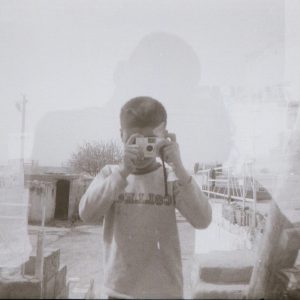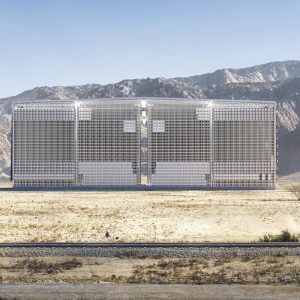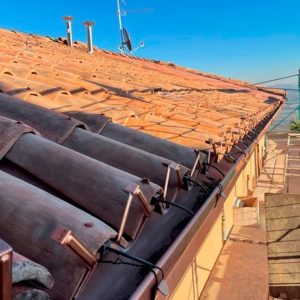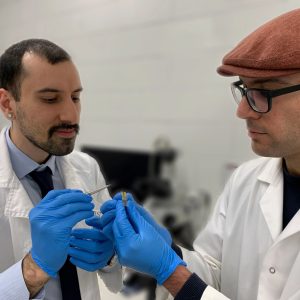Link About It: This Week’s Picks
How ancient grains could be the future of food, responsible use of AI, clean energy ideas and more from around the web

How Origami Is Innovating Technology
 Origami dates back to the 17th century in Japan, but it wasn’t until the mid-20th century that people began to consider the practice an art form due, in large part, to origami master Akira Yoshizawa. Since then, origami has gone on to become a respected art and now a tool to revolutionize science and technology. For example, the patterns and folds in origami, when applied to numbers, have resulted in innovative creations. For instance, the Miura-ori pattern was used as collapsible solar panels for Japan’s Space Flyer Unit in 1995. In the world of biomedicine, origami has inspired a robot, developed by Daniela Rus and her team, that can fold into a pill capsule and when ingested, unfold and be directed around the body. Elsewhere, origami has informed the protection of face masks, the mobility of gears and the understanding of cells. Learn more about how the historic art form continues to inspire at National Geographic.
Origami dates back to the 17th century in Japan, but it wasn’t until the mid-20th century that people began to consider the practice an art form due, in large part, to origami master Akira Yoshizawa. Since then, origami has gone on to become a respected art and now a tool to revolutionize science and technology. For example, the patterns and folds in origami, when applied to numbers, have resulted in innovative creations. For instance, the Miura-ori pattern was used as collapsible solar panels for Japan’s Space Flyer Unit in 1995. In the world of biomedicine, origami has inspired a robot, developed by Daniela Rus and her team, that can fold into a pill capsule and when ingested, unfold and be directed around the body. Elsewhere, origami has informed the protection of face masks, the mobility of gears and the understanding of cells. Learn more about how the historic art form continues to inspire at National Geographic.
Image courtesy of NASA/Dorde Masovic
Sirkhane Darkroom’s Photography Program For Children in Syria, Turkey and Iraq
 Sirkhane Darkroom is a non-profit organization that seeks to provide free photography training to children who have been impacted by war, violence or poverty in Syria, Turkey and Iraq. Founded by Syrian photographer Serbest Salih, the project includes a traveling, flexible eight-week program where students learn how to use a camera, nurture their creative expression and develop their own photos. For many of the kids who are dealing with tumultuous circumstances, photography serves as an outlet for navigating trauma and connecting with themselves. The program also aims to protect and prolong the sanctity of childhood, offering fun activities and welfare services when necessary. At the end of the program, the students select work that they wish to be exhibited. Thus far, the collection suffuses tender and visceral photography that reflects a sense of childlike wonder as well as profound reflections on everyday life. Learn more about the program at It’s Nice That.
Sirkhane Darkroom is a non-profit organization that seeks to provide free photography training to children who have been impacted by war, violence or poverty in Syria, Turkey and Iraq. Founded by Syrian photographer Serbest Salih, the project includes a traveling, flexible eight-week program where students learn how to use a camera, nurture their creative expression and develop their own photos. For many of the kids who are dealing with tumultuous circumstances, photography serves as an outlet for navigating trauma and connecting with themselves. The program also aims to protect and prolong the sanctity of childhood, offering fun activities and welfare services when necessary. At the end of the program, the students select work that they wish to be exhibited. Thus far, the collection suffuses tender and visceral photography that reflects a sense of childlike wonder as well as profound reflections on everyday life. Learn more about the program at It’s Nice That.
Image courtesy of Bünyamin/Sirkhane Darkroom
Using Abandoned Mines to Store Renewable Energy
 There are roughly 550,000 abandoned mines in the US. This vast amount of space might be the solution for scientists who have been researching ways to store renewable energy. In a study led by the International Institute for Applied Systems Analysis, researchers devised a gravity battery using millions of mines worldwide. For this concept, they proposed lowering sand underground when energy is at its peak. Then, using regenerative braking, they converted the sand’s potential energy into actual energy, where it’s stored in the shaft without any loss over time. This method is cheaper than other alternatives, takes advantage of pre-existing connections to power grids and avoids the unsightly infrastructure that commonly comes with energy storage. Learn more about the benefits of this clever system at Popular Mechanics.
There are roughly 550,000 abandoned mines in the US. This vast amount of space might be the solution for scientists who have been researching ways to store renewable energy. In a study led by the International Institute for Applied Systems Analysis, researchers devised a gravity battery using millions of mines worldwide. For this concept, they proposed lowering sand underground when energy is at its peak. Then, using regenerative braking, they converted the sand’s potential energy into actual energy, where it’s stored in the shaft without any loss over time. This method is cheaper than other alternatives, takes advantage of pre-existing connections to power grids and avoids the unsightly infrastructure that commonly comes with energy storage. Learn more about the benefits of this clever system at Popular Mechanics.
Image courtesy of Energy Vault
Solar Panels Disguised As Terracotta Tiles
 Dyaqua is a family-owned Italian company that makes traditional-looking terracotta roof tiles that disguise solar photovoltaic cells. These solar panels, which the company named Invisible Solar, are almost indistinguishable from Italy’s historic roof tiles, yet they are made from a polymer that allows sunlight to filter through. Within, hand-placed photovoltaic cells capture light to convert to energy. Already, Invisible Solar is installed in Pompeii with plans for a larger installation in Evora, Portugal. While these solar panels may not generate as much energy as the original, the method can be applied to other materials like concrete or stone, creating more opportunities for infrastructure to be renewable where they might otherwise not be. Learn more at Fast Company.
Dyaqua is a family-owned Italian company that makes traditional-looking terracotta roof tiles that disguise solar photovoltaic cells. These solar panels, which the company named Invisible Solar, are almost indistinguishable from Italy’s historic roof tiles, yet they are made from a polymer that allows sunlight to filter through. Within, hand-placed photovoltaic cells capture light to convert to energy. Already, Invisible Solar is installed in Pompeii with plans for a larger installation in Evora, Portugal. While these solar panels may not generate as much energy as the original, the method can be applied to other materials like concrete or stone, creating more opportunities for infrastructure to be renewable where they might otherwise not be. Learn more at Fast Company.
Image courtesy of Dyaqua
Useful Secrets Within a 4.2-Billion-Year-Old Asteroid
 Three tiny fragments were collected by a Japanese spacecraft in 2005 from a 4.2-billion-year-old asteroid known as Itokawa. Smaller than the diameter of a hair, these components contain information that could help prevent an asteroid colliding with Earth. Itokawa, a rubble-pile asteroid (created when “solid asteroids collide and the resulting fragments assemble into new structures”), is almost as old as the solar system itself. Held together by a gravitational pull between its composing elements (dust, pebbles, rocks and a void), rubble-pile asteroids are “giant space cushions,” that are good at absorbing shock. Because they are so resilient, scientists believe that the best way for them to avoid a collision with Earth would be to nudge it off course, “but that would probably require a lead time of several years.” The lead author of the study, professor Fred Jourdan of Curtin University, says that more than understanding how to deflect different asteroids, this study reveals just how much can be understood from a few specks of dust. “We can get big stories like that out of [something] very, very small… Every grain has its own story to tell.” Read more at The Guardian.
Three tiny fragments were collected by a Japanese spacecraft in 2005 from a 4.2-billion-year-old asteroid known as Itokawa. Smaller than the diameter of a hair, these components contain information that could help prevent an asteroid colliding with Earth. Itokawa, a rubble-pile asteroid (created when “solid asteroids collide and the resulting fragments assemble into new structures”), is almost as old as the solar system itself. Held together by a gravitational pull between its composing elements (dust, pebbles, rocks and a void), rubble-pile asteroids are “giant space cushions,” that are good at absorbing shock. Because they are so resilient, scientists believe that the best way for them to avoid a collision with Earth would be to nudge it off course, “but that would probably require a lead time of several years.” The lead author of the study, professor Fred Jourdan of Curtin University, says that more than understanding how to deflect different asteroids, this study reveals just how much can be understood from a few specks of dust. “We can get big stories like that out of [something] very, very small… Every grain has its own story to tell.” Read more at The Guardian.
Image courtesy of SETI
Ancient Seeds From the Fertile Crescent Save Crops From Climate Change
 In Terbol, Lebanon, the International Center for Agricultural Research in the Dry Areas (ICARDA) stores tens of thousands of seeds sourced from the Fertile Crescent region—an area in Western Asia and North Africa that encompasses modern-day countries including Iraq, Turkey, Syria, Lebanon, Palestine, Israel and Egypt. The collection, which comprises many seeds from the early origins of agriculture, is part archive, part insurance plan for varietals that go extinct and part research hub where scientists use these ancient seeds to create crops that can withstand our rapidly warming environment. In working with researchers at ICARDA, farmer Dil Thavarajah has bred lentils that contain low digestible carbohydrates. Thavarajah found that these old legume seeds carry humectants, a substance that absorbs moisture and prevents plants from freezing and drying out. Using this gene, Thavarajah developed a legume plant that can grow in the winter in South Carolina—the first crop of its kind to do so. Learn more about these innovations at NPR.
In Terbol, Lebanon, the International Center for Agricultural Research in the Dry Areas (ICARDA) stores tens of thousands of seeds sourced from the Fertile Crescent region—an area in Western Asia and North Africa that encompasses modern-day countries including Iraq, Turkey, Syria, Lebanon, Palestine, Israel and Egypt. The collection, which comprises many seeds from the early origins of agriculture, is part archive, part insurance plan for varietals that go extinct and part research hub where scientists use these ancient seeds to create crops that can withstand our rapidly warming environment. In working with researchers at ICARDA, farmer Dil Thavarajah has bred lentils that contain low digestible carbohydrates. Thavarajah found that these old legume seeds carry humectants, a substance that absorbs moisture and prevents plants from freezing and drying out. Using this gene, Thavarajah developed a legume plant that can grow in the winter in South Carolina—the first crop of its kind to do so. Learn more about these innovations at NPR.
Image courtesy of ICARDA
Using Sound Waves to Triple Battery Life and Reduce E-Waste
 Researchers at Melbourne, Australia’s RMIT University developed an acoustic device that can remove performance-inhibiting rust from batteries, tripling their lifespan and, hopefully, reducing how frequently they are discarded. The researchers used MXene, a nano-material that holds promise as an alternative to lithium batteries, yet is prone to rust. They discovered that high-frequency sound waves cause the MXene battery to vibrate with enough force for the rust to fall off. Battery longevity is crucial to the environment as 74 million metric tons of electronic waste are expected to end up in landfills globally by 2030, according to the UN’s E-Waste Monitor. The new method opens opportunities to improve the use of technology while decreasing pollution. Learn more about it at The New Daily.
Researchers at Melbourne, Australia’s RMIT University developed an acoustic device that can remove performance-inhibiting rust from batteries, tripling their lifespan and, hopefully, reducing how frequently they are discarded. The researchers used MXene, a nano-material that holds promise as an alternative to lithium batteries, yet is prone to rust. They discovered that high-frequency sound waves cause the MXene battery to vibrate with enough force for the rust to fall off. Battery longevity is crucial to the environment as 74 million metric tons of electronic waste are expected to end up in landfills globally by 2030, according to the UN’s E-Waste Monitor. The new method opens opportunities to improve the use of technology while decreasing pollution. Learn more about it at The New Daily.
Image courtesy of RMIT University
Edward Tian’s App Combats Misuse of ChatGPT
 The useful, intelligent AI tool ChatGPT can answer questions, tell stories, compose emails and even write essays. While versatile, the machine-learning technology has opened up avenues for misuse and plagiarism, and drawn criticism for discouraging human writing. These drawbacks spurred Edward Tian, a 22-year-old college student at Princeton University, to create GPTZero, an app built from GitHub Co-Pilot that scans text to determine whether another AI wrote it. “This technology is incredible. I do believe it’s the future. But, at the same time, it’s like we’re opening Pandora’s Box. And we need safeguards to adopt it responsibly,” says Tian. “Human writing can be so beautiful, and there are aspects of it that computers should never co-opt. And it feels like that might be at risk if everybody is using ChatGPT to write.” Tian’s early, innovative app is a first step toward living thoughtfully and responsibly with AI tools. Learn more about it at NPR.
The useful, intelligent AI tool ChatGPT can answer questions, tell stories, compose emails and even write essays. While versatile, the machine-learning technology has opened up avenues for misuse and plagiarism, and drawn criticism for discouraging human writing. These drawbacks spurred Edward Tian, a 22-year-old college student at Princeton University, to create GPTZero, an app built from GitHub Co-Pilot that scans text to determine whether another AI wrote it. “This technology is incredible. I do believe it’s the future. But, at the same time, it’s like we’re opening Pandora’s Box. And we need safeguards to adopt it responsibly,” says Tian. “Human writing can be so beautiful, and there are aspects of it that computers should never co-opt. And it feels like that might be at risk if everybody is using ChatGPT to write.” Tian’s early, innovative app is a first step toward living thoughtfully and responsibly with AI tools. Learn more about it at NPR.
Image courtesy of Edward Tian
Link About It is our filtered look at the web, shared daily in Link and on social media, and rounded up every Saturday morning. Hero image courtesy of SETI











